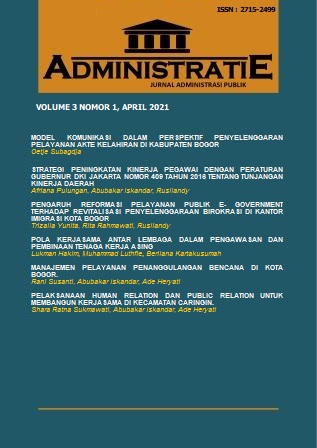STRATEGI PENINGKATAN KINERJA PEGAWAI DENGAN PERATURAN GUBERNUR DKI JAKARTA NOMOR 409 TAHUN 2016 TENTANG TUNJANGAN KINERJA DAERAH
Abstract
This research is motivated by the State Civil Apparatus who have the same income between diligent employees and those who are not diligent in performing, thus making employees not enthusiastic in carrying out government tasks, therefore, the Governor of DKI Jakarta made Governor Regulation Number 409 of 2016 concerning regional performance allowances as a strategy to improve employee performance. Therefore, research is conducted on the effectiveness of this strategy in improving employee performance, it is important to conduct research, to prove the correlation between the implementation of the governor's Regulation No. 409 of 2016 policy with employee performance. This study used an associative approach with a population of 260 employees, which were then sampled using a technique from the Krejcie table as many as 155 employees. This sample data was taken using observation techniques, questionnaires, in-depth interviews, and literature studies. then the data taken in the field were analyzed by associative data analysis techniques. The results of the study indicate that there is a significant effect between the implementation of Governor Regulation number 409 of 2016 and employee performance. It is evident from the results of data analysis calculated using SPSS with a value of tcount > ttable (11.549 > 1.960).
Key words: Performance, Regulations, Benefits, Government Employees
References
As’ad, 2012, Psikologi Industri, Cetakan Keduabelas, Yogyakarta : Liberty.
Dharma, Agus, 2004, Manajemen Supervisi, Jakarta : RajaGrafindo Persada
Abdul Wahab, Solichin. 2004. Analisis Kebijaksanaan dari Formulasi ke Implementasi Kebijaksanaan Negara . Jakarta: Bumi Aksara.
Adi Nugroho. 2009. Rekayasa Perangkat Lunak Menggunakan UML Dan Java ANDI: Yogyakarta.
Al Rasyid, Harun. 2000. Dasar-dasar statistika terapan. Bandung: program pascasarjana UNPAD.
Ambar Teguh Sulistiyani dan Rosidah, 2003, Manajemen Sumber Daya Manusia, Graha Ilmu: Yogyakarta
Anwar Prabu Mangkunegara, 2000, Manajemen Sumber Daya Manusia Perusahaan, Cetakan Ke-2, PT. Remaja Rosda Karya, Bandung
Armstrong, M. and Baron, A. 1998.PerformanceManagement–The NewRealities. London: Institute of Personnel and Development
Bass, B.M, 1990, From Transactional to Transformational Leadership : Learning to Share the Vision. Organizational Dynamics. Dalam Steers, R.M. Porter W, dan Bigley, G.A. (Eds).1996. Motivation and Leadership at Work Sixth Edition, New York : The McGraw-Hill companies. 628-640.
Bass, B.M. (1985). Leadership and Performance Beyond Expectations. New York: The Free Press
Behavior. 4th. Ed. John Wiley & Sons.
Bernardine R Wirjana, M.S.W., dan Susilo Supardo, 2005, Kepemimpinan, Dasar-dasar dan Pengembangannya, Yogyakarta, Andi Offset.
Burns, J.M. 1978. Leadership. Harper & Row. New York, NY.
Cahayani, Ati. 2005.Strategi dan Kebijakan Manajemen Sumber Daya Manusia.Penerbit Indeks, Jakarta.
Dale, Timpe (2002) Seri Manajemen Sumber Daya Manusia Kinerja, cetakan kelima, Jakarta : PT Elex Media Komputindo
Davis, Gordon B. (1993). Reading in Management InformationSystem. M cGraw-Hill, New York
Davis, K. & Newstrom, J.W. (1996). Perilaku dalam Organisasi. Jilid 1. Jakarta: Erlangga.
Dunn, William N. (2003). Analisis Kebijakan Publik . Yogyakarta: Gadjah Mada University Press.
Garry Dessler, 2008. Human Resource Management. Edisi Sebelas, New Jersey : Pearson Education, Inc.
Hill, Michael dan Peter Hupe. 2002. Implementing Public Policy: Governance in Theory and in Practice. London-Thousand Oak-New Delhi: Sage Publication.
Ilyas, Yaslis 2002, Kinerja : Teori, Penilaian, dan Penelitian, Pusat Kajian Ekonomi Kesehatan Fakultas Kesehatan Masyarakat Universitas Indonesia, Depok.
Jonathan Sarwono, Metode Penelitian Kuantitatif & Kualitatif, (Yogyakarta; Graha Ilmu, 2006, Hal. 111)
Kouzes JM, Posner BZ. 2007. The Leadership Challenge. Callifornia: Jossey- Bass Publishing Company.
Nanus, Burt. (1992). Visionary Leadership. San Francisco, CA: Jossey-Bass.
Ndraha, Taliziduhu, 2005. Kybernologi Sebuah Rekonstruksi Ilmu Pemerintahan. Rineka Cipta, Jakarta.
P. Siagian, Sondang.2002. Kepemimpinan Organisasi & Perilaku Administrasi, Jakarta: Penerbit Gunung Agung
Prawirosentono, Suyadi. (1997). Kebijakan Kinerja Karyawan. Yogyakarta : Ravianto.J. (1989). Kualitas dan Produktivitas.Jakarta : Lembaga Sarana Informasi Usaha Dan Produktivitas.
Robbins, Stephen P. 2001. Perilaku Organisasi: Konsep, Kontroversi, Aplikasi, Jilid 1, Edisi 8,Prenhallindo, Jakarta.
Sagala, Syaiful. (2007). Konsep dan Makna Pembelajaran. Bandung: CV. ALFABETA
Schermerhorn, J., J. Hunt, & R. Osborn 1991. Managing Organizational
Soekanto, Soejono. 1990. Sosiologi Suatu Pengantar .Jakarta.PT Raja Grafindo Persada.
Sunggono, Bambang. 1994. Hukum dan Kebijaksanaan Publik . Jakarta: Sinar Grafika.
Tachjan. 2008. Implementasi Kebijakan Publik, AIPI, Bandung.
Thoha,Chabib, Kapita Selekta Pendidikan Islam,Yogyakarta: Pustaka Belajar, 1996
Widodo, Joko. (2007). Analisa Kebijakan Publik. Malang:Bayu Media Publishing
Yukl A. Gary, 1998, Kepemimpinan Dalam Organisasi. Jakarta: Prenhallindo
Downloads
Published
How to Cite
Issue
Section
License
Copyright (c) 2021 ADMINISTRATIE Jurnal Administrasi Publik

This work is licensed under a Creative Commons Attribution-NonCommercial-ShareAlike 4.0 International License.
Authors who publish with Jurnal Governansi agree to the following terms:
- Authors retain copyright and grant the journal right of first publication with the work simultaneously licensed under a Creative Commons Attribution 4.0 International License that allows others to share the work with an acknowledgement of the work's authorship and initial publication in ADMINISTRTAIE.
- Authors are able to enter into separate, additional contractual arrangements for the non-exclusive distribution of the journal's published version of the work (e.g., post it to an institutional repository or publish it in a book), with an acknowledgement of its initial publication in ADMINISTRTIE.
- Authors are permitted and encouraged to post their work online (e.g., in institutional repositories or on their website) prior to and during the submission process, as it can lead to productive exchanges, as well as earlier and greater citation of published work.







